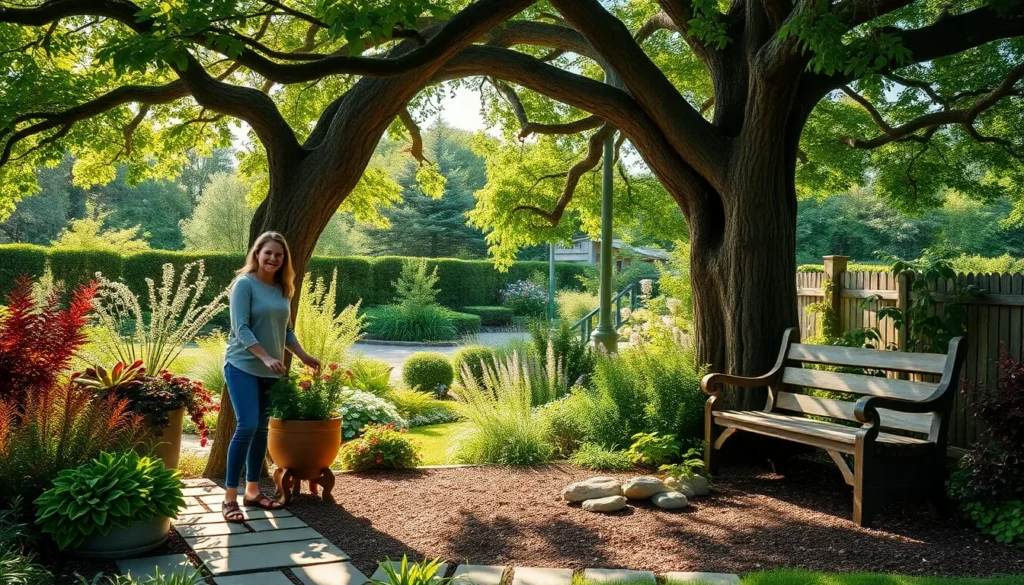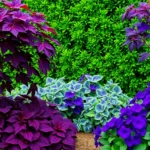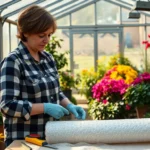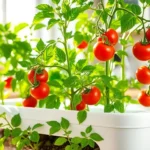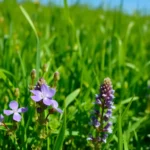That shady spot beneath your favorite tree doesn’t have to remain a barren patch of struggling grass. We’ve discovered countless ways to transform these challenging areas into stunning garden focal points that’ll make your neighbors stop and stare.
Creating a thriving garden under trees presents unique opportunities most gardeners never explore. While shade and root competition might seem like obstacles, they’re actually your ticket to designing something truly special. We’ll show you how to work with nature’s existing framework rather than against it.
From lush hostas that carpet the ground to colorful coral bells that dance in dappled sunlight, the possibilities are endless. Whether you’re dealing with deep shade under a massive oak or filtered light beneath a Japanese maple, we’ve got the perfect plant combinations and design strategies to turn your tree’s underside into a garden masterpiece.
Understanding the Challenges of Gardening Under Trees
Creating thriving gardens beneath trees requires addressing several environmental obstacles that make these spaces particularly challenging. We’ll explore the primary barriers you’ll encounter and how they impact plant selection and garden design.
Poor Light Conditions and Shade Tolerance
Trees create varying degrees of shade that dramatically affect plant growth and flowering potential. Dense canopies filter out 80-95% of available sunlight, while lighter tree coverage may reduce light by 50-70%. We need to assess the exact light conditions throughout the day since some areas receive dappled morning sun but remain shaded by afternoon.
Shade tolerance becomes the most critical factor when selecting plants for under tree gardens. Plants adapted to low light conditions have evolved larger leaves to capture more sunlight and often display different growth patterns compared to sun loving varieties. Many shade tolerant plants produce their most vibrant foliage colors in reduced light conditions, making them perfect candidates for these challenging spaces.
The seasonal changes in canopy density also affect light availability throughout the year. Deciduous trees provide more light during winter months when branches are bare, allowing for early spring bloomers like crocuses and daffodils to thrive before the leaves emerge.
Root Competition and Soil Depletion
Tree roots extend far beyond the visible canopy, creating intense competition for nutrients and space with garden plants. Surface roots from mature trees can consume the majority of available nutrients within the top 12 inches of soil where most garden plants establish their root systems. We often find that shallow rooted plants struggle most in these conditions since they compete directly with tree feeder roots.
Soil depletion occurs when trees extract large quantities of nutrients, particularly nitrogen and phosphorus, leaving insufficient resources for companion plants. Established trees can absorb 50-100 gallons of water daily during peak growing season, significantly reducing soil moisture levels. The soil beneath trees often becomes compacted from reduced organic matter and decreased earthworm activity.
Allelopathic effects from certain tree species like black walnut and eucalyptus release natural chemicals that inhibit growth of nearby plants. These compounds accumulate in soil over time and require exact plant selections that can tolerate or even benefit from these chemical interactions.
Water Access and Drainage Issues
Water distribution under trees creates unique challenges as canopies intercept rainfall and direct moisture away from the root zone. Rain shadow effects can reduce ground level precipitation by 20-40% compared to open garden areas. We notice that water often runs off tree canopies and concentrates in exact drip zones, creating both dry and oversaturated areas within the same garden space.
Drainage problems develop when dense clay soils combine with heavy tree root systems, preventing proper water infiltration and creating waterlogged conditions. Surface roots can create physical barriers that redirect water flow and prevent even moisture distribution throughout the garden bed. These uneven moisture patterns require careful plant placement and often necessitate irrigation system modifications.
Seasonal water availability fluctuates dramatically under trees, with spring offering the most consistent moisture before leaves emerge and summer presenting the driest conditions. We must consider both drought tolerant plants for dry zones and moisture loving species for areas that collect runoff during rainy periods.
Creating a Woodland Wildflower Garden
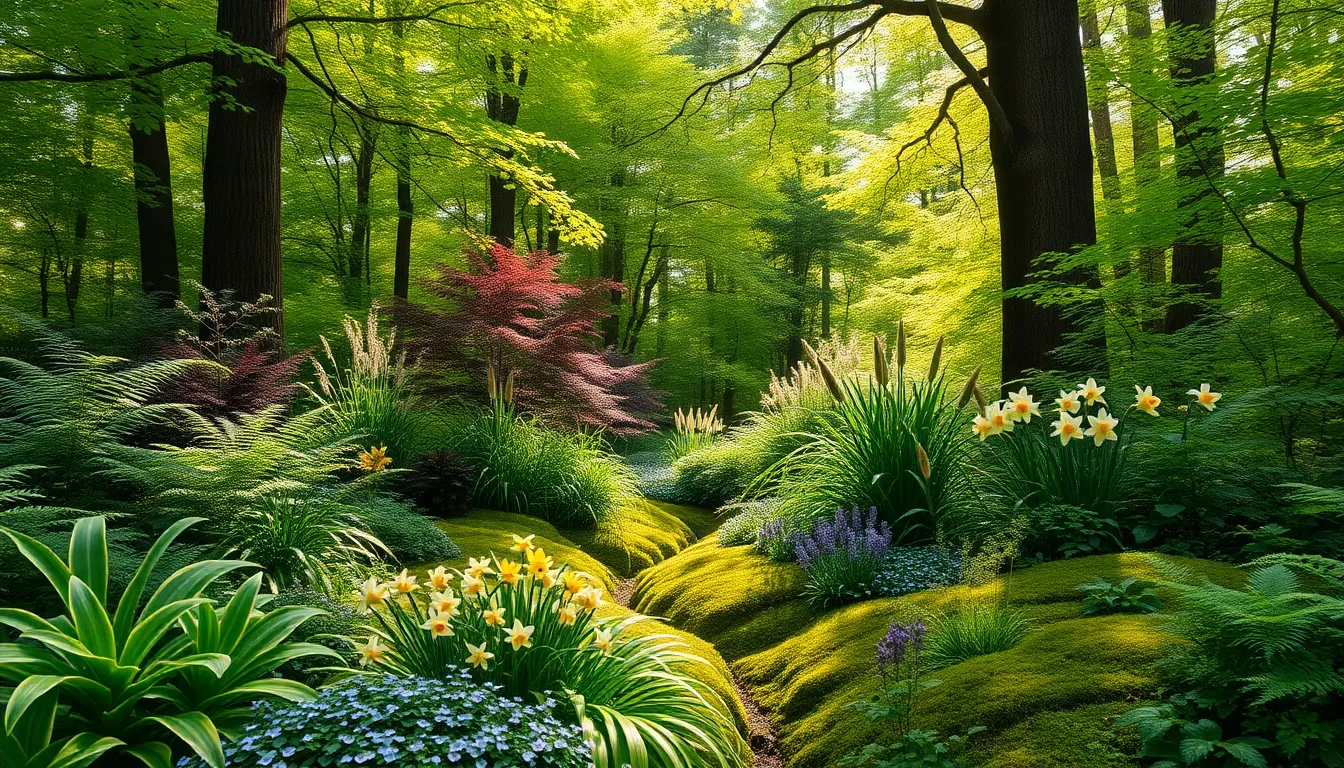
Woodland wildflower gardens offer the perfect solution for transforming those challenging shaded spaces under trees into thriving natural sanctuaries. We’ll explore how to select the right plants and create combinations that work harmoniously with your existing tree canopy.
Native Shade-Loving Perennials
Eastern North America natives like ferns, astilbe, and hostas form the backbone of successful woodland gardens, providing resilience and beauty in shaded environments. Trilliums emerge as early spring showstoppers, displaying their distinctive three-petaled blooms before trees fully leaf out. Violets carpet forest floors with delicate purple and white flowers while offering edible leaves and blooms throughout the growing season.
Cardinal flowers bring brilliant red spikes to summer woodland gardens, attracting hummingbirds and butterflies to shaded areas. Wild ginger spreads naturally through underground rhizomes, creating dense mats of heart-shaped leaves that suppress weeds effectively. Coral bells add year-round interest with their colorful foliage ranging from deep burgundy to bright chartreuse, plus delicate flower spires in late spring.
Evergreen options like Christmas fern and wild ginger provide structure during winter months when deciduous perennials go dormant. We recommend grouping these perennials in odd numbers of three or five to create natural-looking drifts that mimic how plants grow in wild woodland settings.
Seasonal Bulb Combinations
Spring blooming bulbs like daffodils and scilla provide vibrant early color before tree canopies fully develop, taking advantage of increased light levels. Daffodils naturalize easily under trees, returning year after year with larger displays as they multiply through offsets. Scilla’s bright blue flowers create stunning carpets beneath deciduous trees, blooming simultaneously with early daffodil varieties.
Layered planting strategies maximize seasonal interest by combining early, mid, and late spring bulbs in the same area. Wood hyacinths extend the bulb season into late spring, bridging the gap between early bulbs and summer perennials. Alliums provide late spring to early summer blooms, with their spherical flower heads adding architectural interest to woodland gardens.
Summer interest continues with shade-tolerant caladiums and begonias, which thrive in the filtered light conditions created by tree canopies. We suggest interplanting bulbs with emerging perennial foliage to disguise dying bulb leaves naturally as the season progresses.
Natural Groundcover Options
Creeping thyme forms dense, aromatic mats that release fragrance when walked upon, making it ideal for pathways through woodland gardens. Vinca minor spreads rapidly in shaded conditions, producing glossy evergreen leaves and periwinkle blue flowers from spring through fall. Both options require minimal maintenance once established and effectively suppress weed growth through dense coverage.
Fern varieties like Christmas fern and lady fern create textural interest while naturally retaining soil moisture through their dense frond coverage. Wild ginger’s broad, kidney-shaped leaves form natural carpets that prevent soil erosion on slopes under trees. These native groundcovers establish quickly in woodland conditions and require no supplemental watering once their root systems develop.
Moss cultivation works exceptionally well in consistently moist, shaded areas where traditional grass struggles to grow. We recommend encouraging existing moss patches by removing competing vegetation and maintaining consistent moisture levels through mulching. Pachysandra offers another evergreen option that tolerates deep shade and poor soil conditions while providing year-round green coverage.
Designing a Shade Container Garden
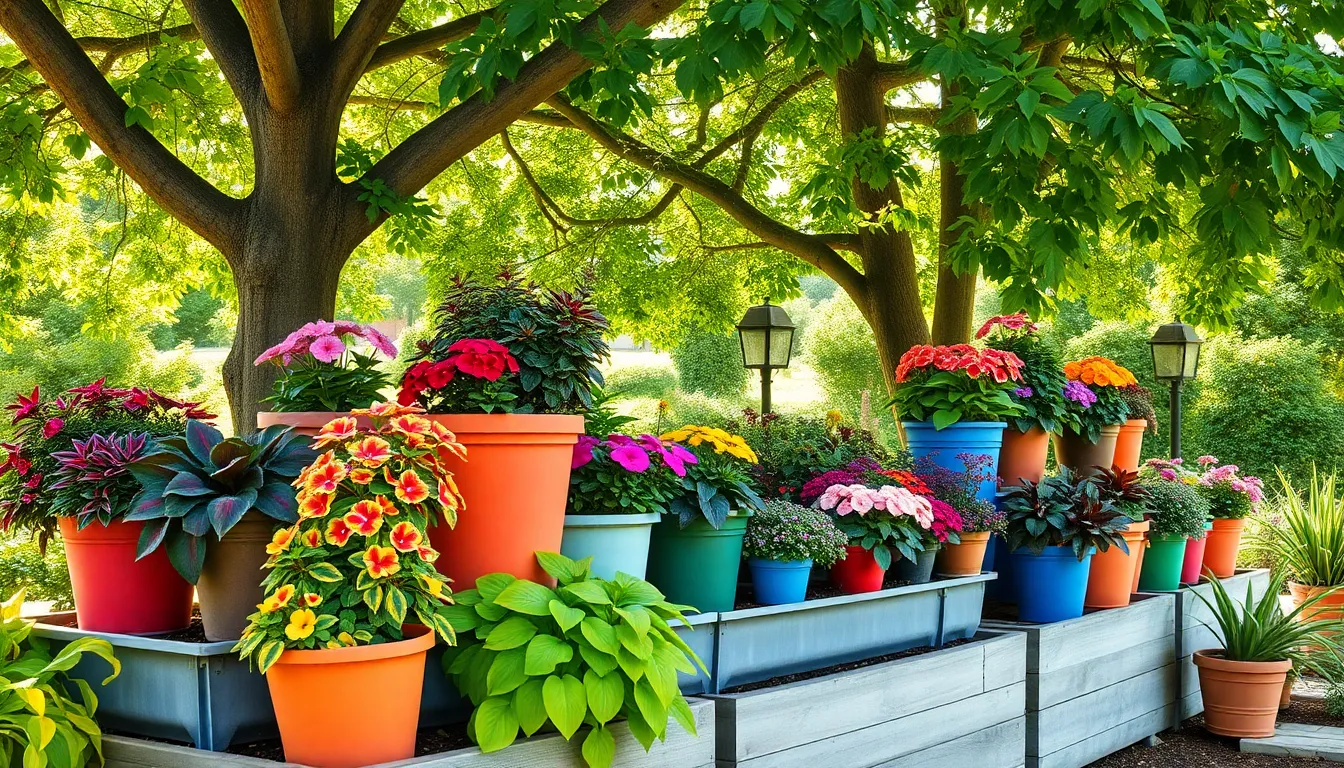
Container gardening offers the perfect solution for areas under trees where traditional planting proves challenging. We can create stunning displays that thrive in low light conditions while maintaining complete control over soil quality and drainage.
Portable Planting Answers
Movable containers transform our garden flexibility, allowing us to optimize growing conditions throughout the seasons. Large wheeled planters let us relocate shade loving plants like hostas and astilbes to capture morning sun or protect them from harsh afternoon heat.
Rolling plant caddies maximize our garden’s potential by enabling quick repositioning during weather changes. We can move delicate impatiens and coleus indoors during frost warnings or shift containers to shadier spots during extreme heat waves.
Versatile planters adapt to changing light conditions as tree canopies develop throughout the growing season. Elevated stands and tiered systems help us position plants at optimal heights to receive filtered sunlight that penetrates through overhead branches.
Seasonal Container Arrangements
Spring arrangements burst with early color using pansies and violas that tolerate cool temperatures and partial shade conditions. We combine these cheerful bloomers with emerging hosta shoots and delicate fern fronds for textural contrast.
Summer displays feature heat tolerant shade plants like impatiens, coleus, and caladiums that provide continuous color from June through September. Sweet potato vines cascade beautifully from elevated containers while adding dramatic foliage texture to our shade garden designs.
Fall transitions incorporate plants with autumnal hues such as ornamental kale and chrysanthemums that complement the changing tree canopy above. We add seasonal decorations like pinecones and colorful leaves to extend visual interest through the harvest season.
Creative Pot Placement Ideas
Tiered planting systems maximize vertical space using stacked planters and garden shelves that create dramatic height variations. We arrange containers in ascending sizes to establish focal points while ensuring each plant receives adequate light penetration.
Strategic placement around tree bases creates visually integrated garden designs that complement natural industry features. Grouping containers of varying heights and textures helps us establish rhythm and flow within our shade garden compositions.
Brightly colored and shiny metal pots add visual impact to naturally dim spaces under tree canopies. We select containers in vibrant blues, yellows, and metallics that reflect available light while creating striking contrasts against dark soil and green foliage.
Building a Moss and Fern Garden Sanctuary
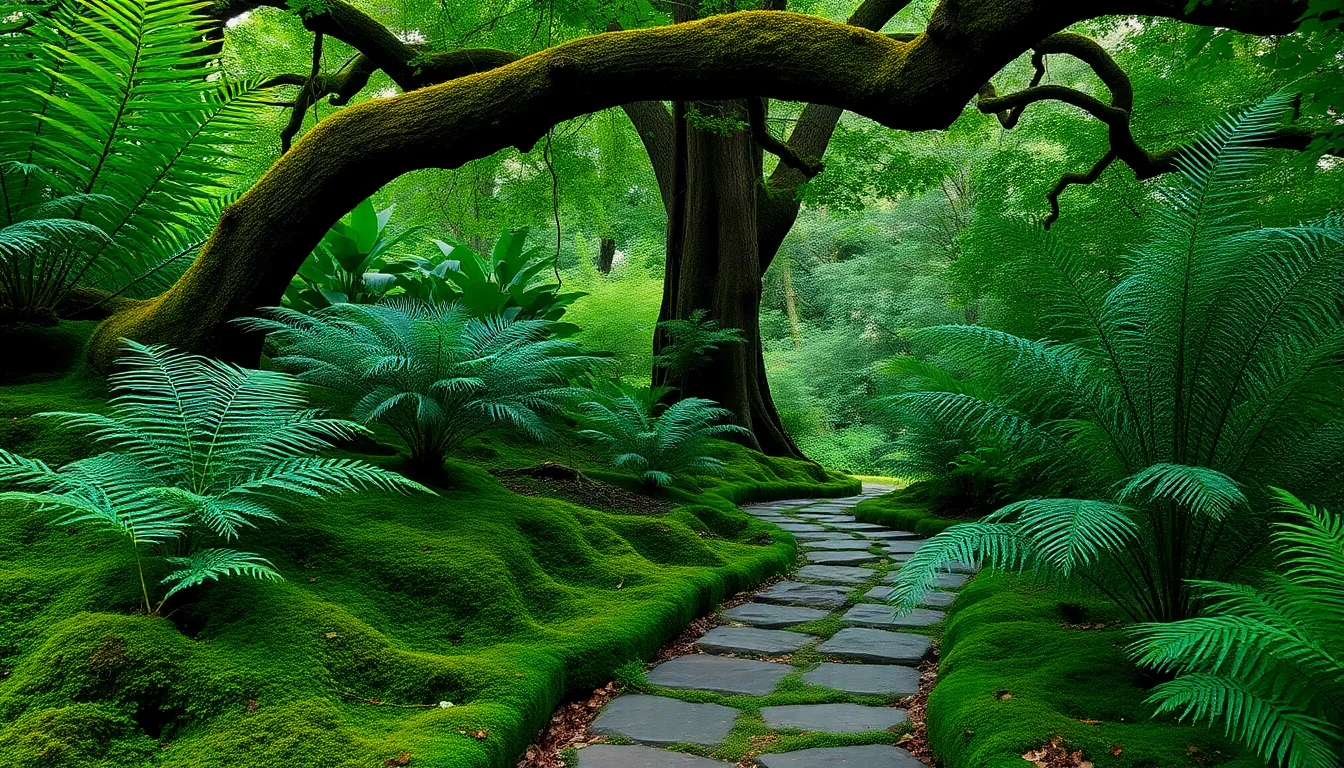
Creating a moss and fern sanctuary transforms challenging under tree spaces into lush, tranquil garden retreats. We’ll guide you through establishing thriving moss colonies, selecting resilient fern varieties, and incorporating natural stone elements for the perfect woodland oasis.
Establishing Moss Colonies
Moss thrives in the shaded, consistently moist environments found beneath trees, making it an ideal groundcover choice. We recommend starting with moss starter kits or carefully collecting moss specimens from other areas of your property to establish new colonies. Location selection proves critical since moss requires consistent shade and moisture without becoming waterlogged.
Maintaining proper moisture levels ensures successful moss establishment and growth. We suggest misting the area regularly during dry periods while avoiding oversaturation that can lead to rot. Creating microclimates by grouping stones or logs helps retain moisture and provides natural anchoring points for moss colonies to spread.
Selecting Hardy Fern Varieties
Hardy fern varieties adapt beautifully to partial shade conditions provided by tree canopies. We particularly recommend Lady Ferns and Ostrich Ferns for their exceptional resilience and adaptability to various soil conditions. These varieties establish quickly and create lush, layered textures that complement moss groundcover perfectly.
Different fern species offer unique aesthetic qualities for your sanctuary design. Lady Ferns provide delicate, feathery fronds that sway gracefully in light breezes, while Ostrich Ferns create dramatic vertical elements with their tall, arching growth patterns. Both varieties tolerate root competition from trees better than many other shade plants.
Creating Natural Stone Pathways
Natural stone pathways enhance both visual appeal and functionality within moss and fern gardens. We recommend selecting stones that complement your surrounding industry while providing stable walking surfaces through delicate plantings. These pathways help maintain proper moisture levels by allowing water to permeate soil naturally rather than creating runoff.
Stone placement requires careful consideration of both drainage and aesthetic flow. We suggest arranging stones to follow natural contours while creating gentle curves that invite exploration through your sanctuary. Choosing locally sourced stones ensures they fit harmoniously with existing industry elements and weather appropriately over time.
Installing a Mulched Meditation Space
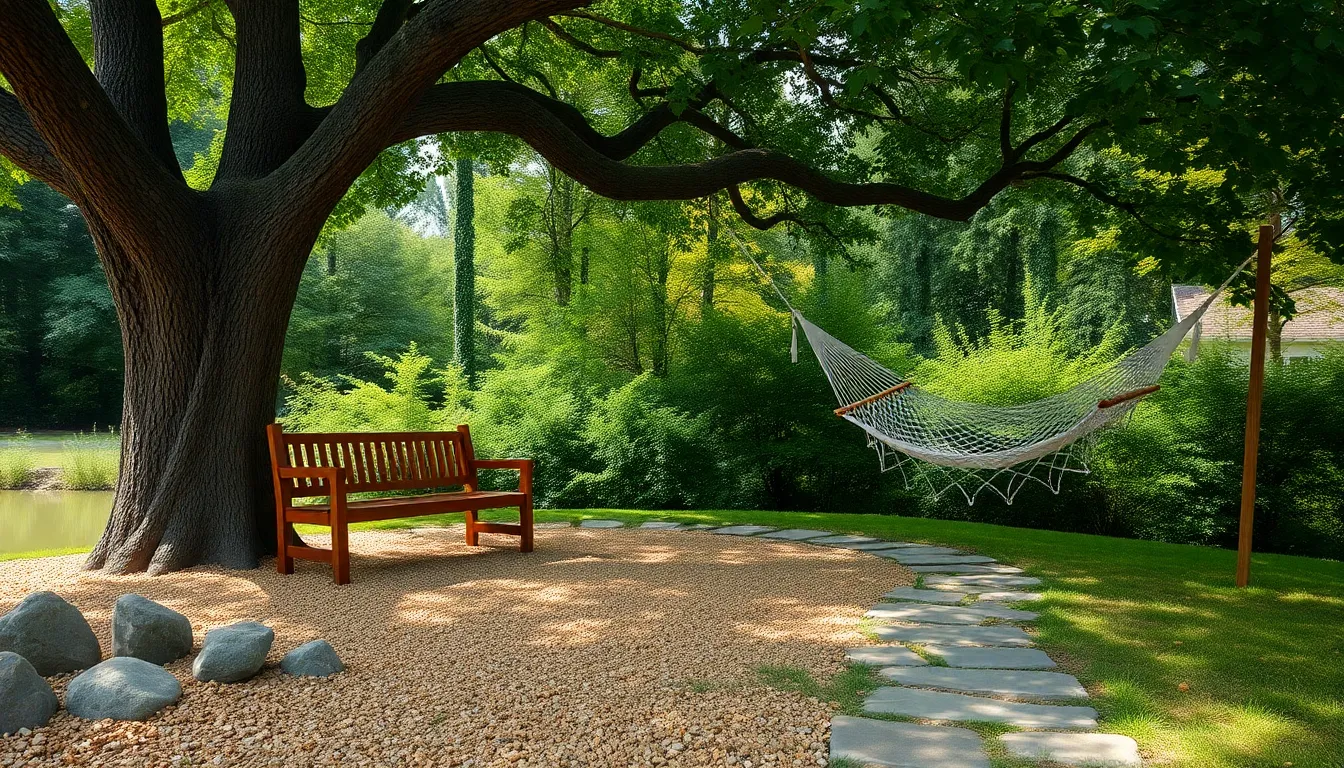
Creating a tranquil meditation zone beneath your favorite tree combines the therapeutic benefits of nature with thoughtful garden design. We’ll guide you through establishing this peaceful retreat using sustainable materials and strategic placement techniques.
Organic Mulch Selection
Wood chips provide the foundation for our meditation space while delivering essential soil benefits. These sustainable materials help retain moisture around tree roots and create a natural carpet that feels comfortable underfoot. Bark mulch offers excellent drainage properties and develops a rich, earthy aroma that enhances the meditative atmosphere.
Leaf mold transforms fallen autumn foliage into premium organic matter for your space. We recommend collecting leaves from oak, maple, or birch trees to create this nutrient rich material that naturally conditions soil over time. Shredded leaves break down gradually and provide a soft, springy surface that’s perfect for barefoot walking or sitting.
Organic mulches suppress weeds naturally while maintaining optimal soil temperature throughout seasons. These materials create an insulating layer that keeps tree roots cool during summer heat and protects them from winter frost. Fresh mulch applications every 12 to 18 months ensure continuous benefits and maintain the aesthetic appeal of your meditation area.
Simple Seating Arrangements
Wooden benches integrate seamlessly with organic mulch surroundings and provide stable meditation platforms. We suggest choosing cedar or teak options that resist weather damage and develop attractive silvery patinas over time. Position benches facing east or south to capture gentle morning sunlight filtering through tree branches.
Hammocks create floating meditation spaces that work especially well under large oak or maple trees. These suspended seating options require sturdy anchor points spaced 12 to 15 feet apart for proper installation. Comfortable hammocks encourage longer meditation sessions while providing gentle swaying motion that enhances relaxation.
Stone seating elements blend naturally with decorative rock features throughout the meditation zone. Large flat stones or constructed stone seats offer permanent seating that requires minimal maintenance. We recommend selecting local stone varieties that complement your existing industry while providing comfortable surfaces for extended sitting.
Decorative Rock Features
Natural stone pathways guide visitors through your meditation space while improving drainage around tree roots. Flagstone or stepping stones create defined walking surfaces that prevent soil compaction in high traffic areas. Spaces between stones allow rainwater to penetrate soil naturally while maintaining easy access to seating areas.
River rocks and decorative boulders add visual interest while serving practical drainage functions. These elements create natural focal points that complement organic mulch textures and colors. Larger stones can double as additional seating options or meditation platforms for visitors who prefer firmer surfaces.
Gravel borders define meditation space boundaries and prevent mulch from spreading into surrounding garden areas. We recommend using pea gravel or decomposed granite to create clean transitions between different industry zones. These materials require minimal maintenance while providing excellent drainage that benefits both tree health and garden aesthetics.
Establishing a Hostas and Heuchera Display
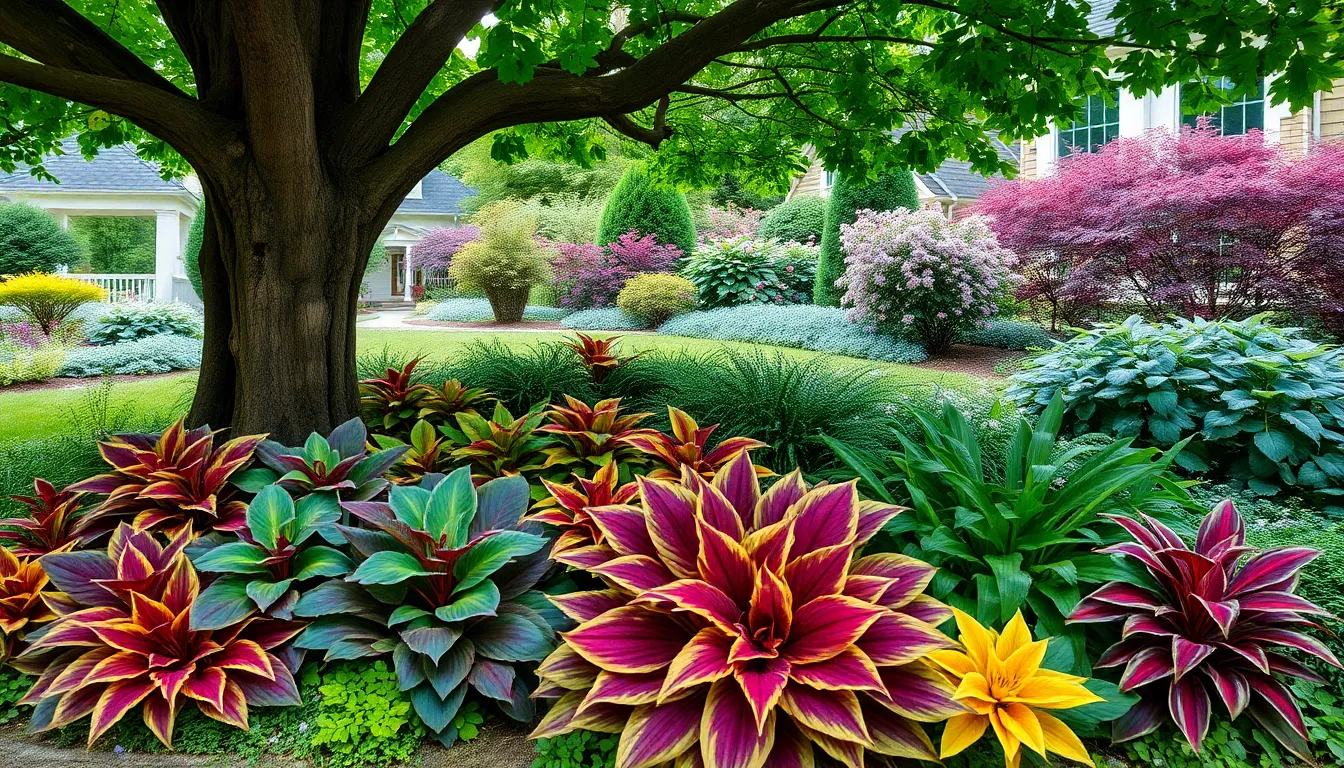
Building on our foundation of shade gardening principles, we’ll explore how hostas and heuchera create stunning displays that thrive beneath tree canopies. These complementary perennials form the backbone of successful under-tree gardens.
Colorful Foliage Combinations
Hostas provide the perfect canvas with their large leaves in various sizes and colors, creating lush backdrops for vibrant companions. We recommend pairing blue-green hosta varieties like ‘Halcyon’ with burgundy heuchera such as ‘Palace Purple’ for dramatic contrast.
Layered plantings work exceptionally well when we combine different foliage textures and colors. Mix golden hostas like ‘Sum and Substance’ with coral-colored heuchera varieties such as ‘Peach Crisp’ to create warm, inviting displays.
Ferns add delicate texture between bold hosta clumps and colorful heuchera patches. Early spring bloomers like epimediums contribute seasonal flowers while maintaining attractive foliage throughout the growing season.
Textural Contrast Planning
Soft foliage plants like hostas and ferns create gentle, flowing textures that contrast beautifully with robust companions. We achieve visual interest by alternating between delicate and substantial plant forms.
Tough foliage options including heuchera and epimedium provide structure with their durable, distinctive leaf shapes. These hardy perennials maintain their architectural presence even in challenging root competition conditions.
Groundcovers such as creeping raspberry or satureja spread between larger specimens to create cohesive plantings. We use these low-growing options to fill gaps and suppress weeds naturally.
Companion Plant Pairings
Hostas paired with muscari create striking spring combinations where blue grape hyacinth flowers emerge before hosta leaves fully develop. This timing ensures both plants receive optimal growing conditions without competing for space.
Heuchera combined with creeping raspberry offers year-round interest through vibrant foliage colors and spreading groundcover benefits. We position heuchera as focal points while allowing raspberry to naturalize in surrounding areas.
Mixed plantings of hostas, heuchera, and flowering companions like astilbe create diverse garden ecosystems. These combinations thrive in similar shade conditions while providing multiple seasons of visual appeal through varied bloom times and foliage displays.
Constructing Raised Garden Beds
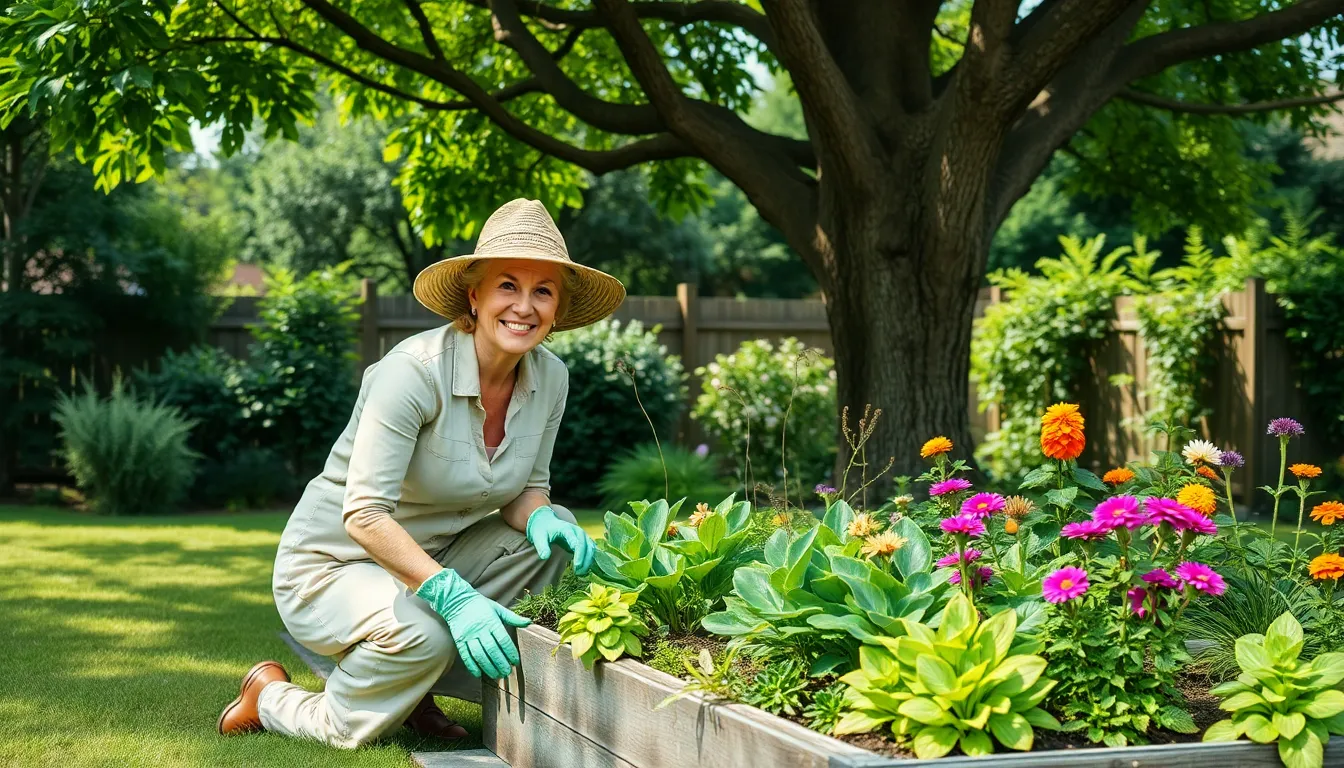
Building raised beds under trees provides superior control over soil quality while protecting valuable tree root systems from damage.
Soil Amendment Strategies
We recommend mixing compost, leaf mold, or well-rotted manure into your existing soil to improve both fertility and structure. Avoid piling soil or mulch directly against tree trunks as this practice leads to harmful rot conditions. Apply only thin layers of organic mulch or compost to the surface, gently working these materials into the topsoil where feeder roots actively absorb nutrients.
Monitor your garden regularly for nutrient deficiencies and supplement with slow-release fertilizers when plants show signs of stress. Quality amendments like aged compost provide long-term soil benefits without overwhelming tree root systems. Organic materials break down gradually, creating the perfect environment for both planted flowers and existing tree health.
Drainage Improvement Techniques
Build your beds with a slight slope to ensure proper water movement and prevent standing water issues. Incorporate coarse sand, perlite, or gravel into your soil mix to enhance drainage capabilities without compromising plant nutrition. Never compact soil under trees as this practice blocks essential water penetration and airflow to root systems.
Install perforated drainage pipes or French drains if persistent waterlogging becomes problematic, but exercise extreme caution to avoid damaging large tree roots. Strategic placement of drainage materials protects both your garden plants and the tree’s established root network. Proper drainage prevents root rot while maintaining the moisture levels necessary for healthy plant growth.
Height Optimization Methods
Raise bed height carefully, keeping most installations just a few inches above ground level for optimal plant performance. Taller beds risk isolating feeder roots from essential moisture and air circulation. Use modular, stackable designs that offer flexibility for future garden modifications and seasonal adjustments.
Fill lower bed layers with coarse drainage materials and reserve upper layers for amended topsoil rich in organic matter. Ensure your beds don’t interfere with the tree’s trunk flare and always leave adequate space for natural root expansion. Select shallow, wide bed designs rather than deep installations to minimize root disturbance while maximizing growing space for your shade-loving plants.
Growing an Edible Shade Garden

We can transform our challenging under tree spaces into productive food gardens by selecting shade tolerant crops. Strategic plant choices allow us to harvest fresh ingredients while working within the natural limitations of reduced sunlight and root competition.
Leafy Greens Selection
Rocket (Arugula) tops our list of shade friendly leafy greens with its impressive tolerance for partial shade conditions. Quick growing characteristics make this peppery green an excellent filler between established plantings while providing continuous harvests throughout the growing season.
Rainbow Chard adapts well to shadier garden locations even though preferring brighter conditions for optimal growth. We’ll notice slower development in these areas, but the colorful stems and nutritious leaves still produce reliable yields for our kitchen needs.
Chilean Wintergreen thrives as both ground cover and food source in our shaded spaces beneath trees. This hardy plant produces edible berries while spreading naturally to suppress weeds and create living mulch layers.
Herb Garden Planning
Dill and Chamomile handle partial shade conditions effectively, making them practical choices for our under tree herb collections. Both plants offer culinary and medicinal benefits while requiring minimal maintenance once established in appropriate locations.
Valerian performs well in partial shade environments while producing attractive flowers that enhance our garden’s visual appeal. We grow this perennial primarily for its medicinal root, though the entire plant contributes to our edible industry design.
Root Vegetable Options
Sweet Potato stands out as our most viable root vegetable choice for partial shade conditions, especially during warmer growing months. Edible leaves function as excellent spinach substitutes while the tubers develop underground, providing dual harvest opportunities from single plantings.
Most root vegetables demand full sun conditions, limiting our options for shade gardens beneath established trees. Sweet potatoes offer the best compromise between shade tolerance and productive yields, making them essential components of our edible under tree gardens.
Creating a Children’s Fairy Garden
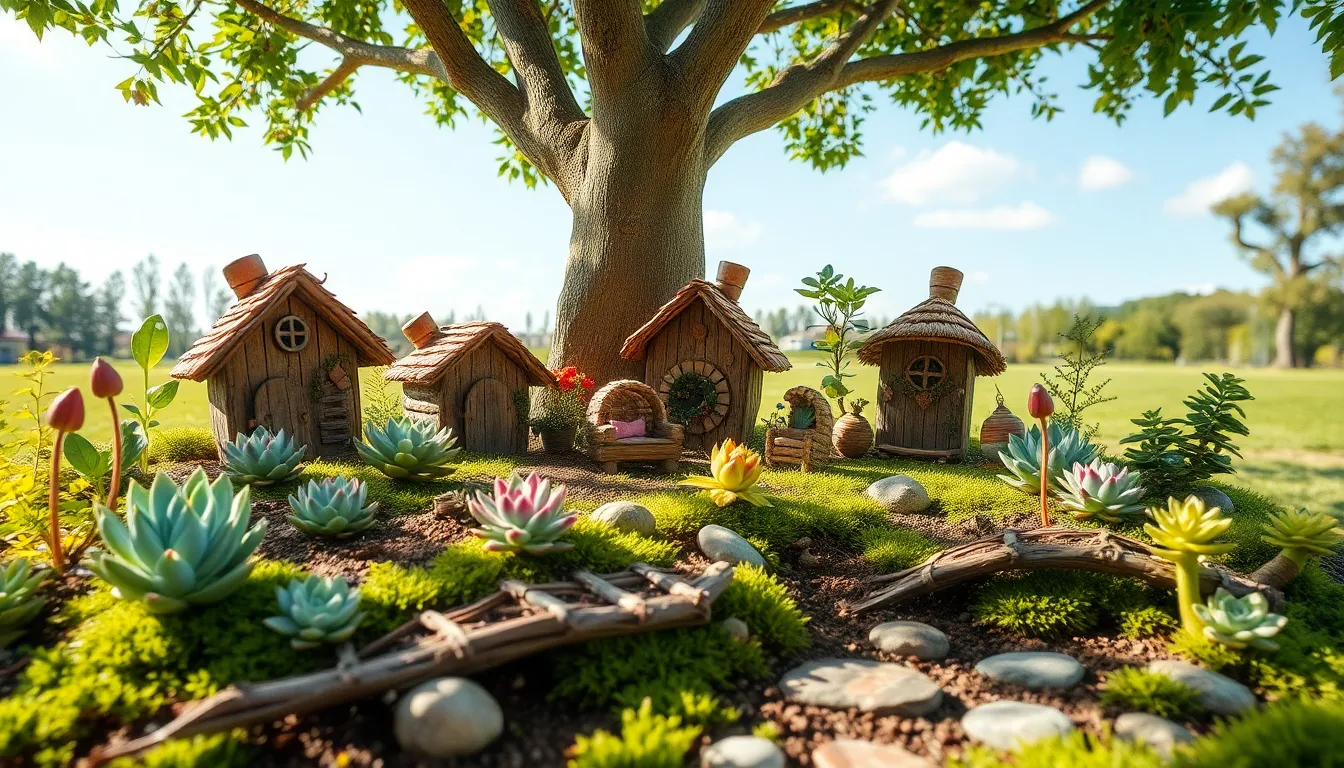
Building a magical fairy garden under your tree creates an enchanting space where children’s imaginations can flourish while working with the natural shade conditions we’ve explored.
Miniature Plant Selections
Succulents offer the perfect starting point for your fairy garden since they’re incredibly low maintenance and thrive in the dappled light beneath tree canopies. Varieties like hen and chicks create natural miniature landscapes that children can easily care for.
Moss becomes your magical carpet in consistently moist shaded areas, providing the soft green foundation that makes fairy gardens feel truly enchanted. We can encourage moss growth by misting regularly and removing competing weeds.
Small flowering plants add vibrant pops of color throughout the growing season. Tiny violas and sweet alyssum work beautifully in partial shade, creating flower beds scaled perfectly for fairy inhabitants.
Miniature hostas and heuchera bring the same dramatic foliage combinations we’ve discussed earlier, but in dwarf varieties that won’t overwhelm the fairy garden scale. These plants provide structure and seasonal interest.
Whimsical Decoration Ideas
Natural fairy houses constructed from acorn caps and moss blend seamlessly with your tree’s network while sparking children’s creativity. We can help kids build these structures using cardboard bases covered with collected natural materials.
Repurposed birdhouses transform into fairy cottages when painted in bright colors and positioned at child height among the plants. These ready made structures save time while providing instant fairy accommodations.
Tiny furniture crafted from twigs and leaves creates authentic outdoor fairy living spaces. Children can construct miniature benches, tables, and swings using natural materials found right under your tree.
Decorative stones and pebbles serve dual purposes as both fairy garden accessories and practical drainage elements. We can paint larger stones to create fairy stepping stones or leave smaller pebbles natural for authentic woodland pathways.
Interactive Garden Elements
Twig and string bridges connect different areas of your fairy garden, encouraging children to create storylines about fairy adventures. These structures span between plant clusters and add vertical interest to the design.
Small doors attached to the tree trunk invite children to imagine fairy homes hidden within the bark. We can use lightweight wooden doors that won’t harm the tree while adding mystery to the garden.
Flat rock stepping stones create fairy pathways that children can rearrange seasonally, teaching them about garden design while providing practical walkways through planted areas. These stones also help protect delicate plants from foot traffic.
Interactive exploration elements like tiny mailboxes and welcome signs encourage children to develop ongoing fairy narratives. We can rotate these accessories seasonally to maintain interest and create new play opportunities throughout the year.
Developing a Low-Maintenance Ground Cover Solution
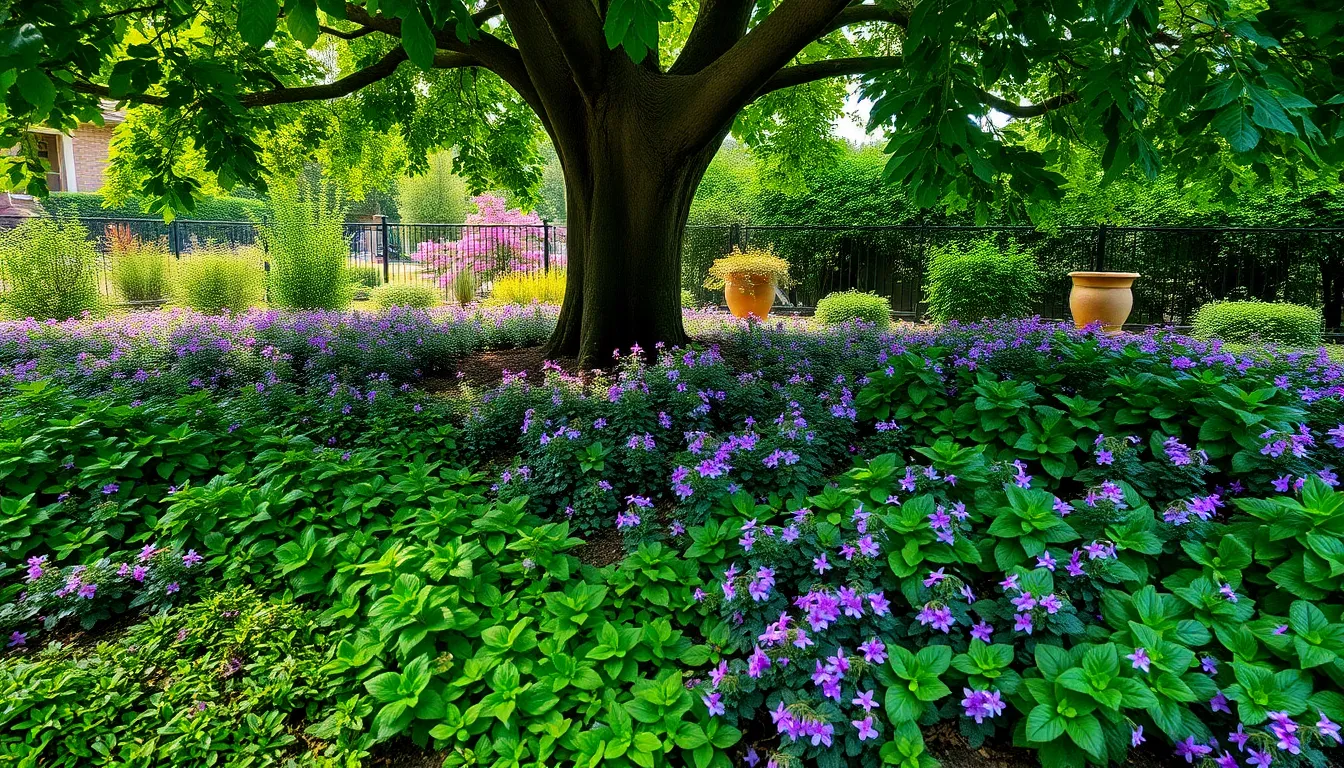
Ground covers provide the perfect solution for areas beneath trees where traditional lawn grass struggles to establish. We’ve selected varieties that require minimal care while delivering maximum impact in challenging shade conditions.
Spreading Perennial Options
Vinca minor (Periwinkle) thrives in various light conditions and stands out as one of our most reliable ground cover choices. This tough perennial spreads naturally to form dense carpets while requiring only occasional pruning to prevent invasion into unwanted areas.
Pachysandra creates dense coverage in deep shade areas where other plants fail to establish. We recommend this option for consistently moist locations where you want reliable evergreen coverage throughout the year.
Lungwort offers attractive spotted foliage and delicate spring flowers while tolerating dry shade conditions. This perennial provides visual interest with its unique leaf patterns and seasonal blooms that brighten darker garden areas.
Epimediums (Barrenworts) excel in dry, shady sites with minimal maintenance requirements. These hardy perennials produce delicate flowers in spring and maintain attractive foliage throughout the growing season.
Creeping Raspberry (Rubus pentabulous) spreads up to 4 feet and provides excellent deer resistance for problem areas. We find this option particularly valuable in locations where wildlife browsing creates ongoing challenges for other ground covers.
Self-Seeding Annual Varieties
Wild Violets naturally reseed themselves and add seasonal color without requiring replanting efforts. These charming annuals establish colonies that return year after year while providing early spring blooms in shaded areas.
Annual varieties complement perennial ground covers by filling gaps and adding seasonal interest. We suggest allowing these self seeding plants to naturalize in areas where you want changing displays throughout different seasons.
Erosion Control Benefits
Ground covers stabilize soil with extensive root systems that prevent erosion on sloping terrain. We particularly value Vinca minor and Pachysandra for their dense root structures that hold soil in place during heavy rainfall periods.
Established ground cover systems reduce maintenance needs while protecting valuable topsoil from washing away. These plantings create natural barriers that slow water runoff and allow better moisture absorption into the surrounding soil.
Root competition from ground covers actually benefits the overall garden network by creating stable growing conditions. We’ve observed that areas with established ground cover systems require less supplemental watering and show improved soil structure over time.
Conclusion
Transforming the shaded spaces beneath our trees doesn’t have to be a gardening challenge anymore. We’ve explored countless possibilities that turn these neglected areas into thriving garden sanctuaries.
Whether we choose native wildflowers mossy retreats or raised beds filled with leafy greens each approach offers unique rewards. Container gardens provide flexibility while fairy gardens spark imagination and ground covers solve maintenance concerns.
The key lies in working with nature rather than against it. By understanding our trees’ needs and selecting appropriate plants we create harmonious ecosystems that benefit both our industry and local wildlife.
These under-tree gardens prove that every corner of our outdoor space holds potential. With the right knowledge and creative vision we can transform what once seemed impossible into our garden’s most enchanting feature.
Frequently Asked Questions
What are the main challenges of gardening under trees?
The primary challenges include poor light conditions (with tree canopies filtering 80-95% of sunlight), root competition for nutrients and moisture, soil depletion, and uneven water distribution. Dense canopies create both dry and oversaturated areas, while tree roots often lead to compacted soil conditions that make traditional gardening difficult.
Which plants work best in shaded areas under trees?
Shade-tolerant plants like hostas, ferns, astilbe, and coral bells thrive under trees. Early spring bloomers such as trilliums and violets work well, along with summer favorites like cardinal flowers. For groundcover, consider creeping thyme, vinca minor, pachysandra, and various fern varieties that require minimal maintenance.
Can I grow food in shaded garden areas?
Yes, several edible plants thrive in partial shade. Leafy greens like arugula and rainbow chard grow well in low-light conditions. Herbs such as dill and chamomile can be successfully cultivated, while sweet potatoes offer dual harvest opportunities from both their leaves and tubers in shaded environments.
How do I create a container garden under trees?
Container gardening offers excellent control over soil quality and drainage while allowing flexibility to move plants for optimal light exposure. Use seasonal arrangements with spring pansies, summer impatiens and coleus, and fall ornamental kale. Consider tiered systems and brightly colored containers to enhance visual appeal.
What’s the best way to establish moss and fern gardens?
Create thriving moss colonies by maintaining proper moisture levels and establishing microclimates using natural stone elements. Select resilient fern varieties like Lady Ferns and Ostrich Ferns that adapt well to partial shade. Incorporate natural stone pathways for visual appeal and proper drainage.
Should I build raised beds under trees?
Raised beds can improve soil quality while protecting tree roots. Keep installations low to avoid isolating roots and ensure proper circulation. Use soil amendments like compost, build with slight slopes for drainage, and incorporate materials like sand and gravel. Never pile materials against tree trunks.
How do I create low-maintenance groundcover solutions?
Choose reliable options like Vinca minor, Pachysandra, Lungwort, and Epimediums that require minimal care while providing erosion control. Self-seeding annuals like Wild Violets add seasonal color. Established groundcover systems help stabilize soil and improve overall garden health with little ongoing maintenance required.
Can I create a meditation space under trees?
Absolutely! Install organic mulches like wood chips and leaf mold for soil benefits and comfortable surfaces. Add simple seating like wooden benches, hammocks, or stone elements. Incorporate decorative rock features and natural stone pathways to improve drainage and define the space while adding visual interest.

